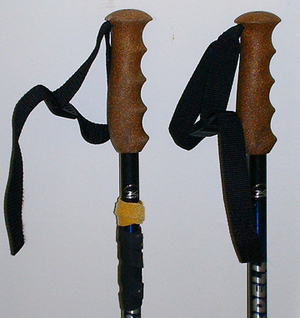What are trek poles? Anyone who uses trek poles when backpacking, hiking or walking knows the physical benefits. Their use relieves stress on knee and ankle joints, improves the cardiovascular workout through arm movement, and aids in balance. For those three reasons alone every pair of feet should come with a pair of trek poles. Whether it is mountain trails in Colorado or well-worn paths in local parks I have at least one trek pole in my hand
Technology improved the carved wooden walking stick. Think of them as ski poles that will help you slide across rock, dirt, mud and grass.
The shafts are made of strong lightweight aluminum or titanium and have two to three telescoping sections. When the length is adjusted to the user they are locked in place. A twist locks expander poles, some have a push button system or a snap lock. Grips are formed from synthetic materials or dense cork and are straight or slanted for ergonomic comfort. Spring shock absorbers inside the shaft reduce the stress on knee and ankle joints. Web straps keep the poles in hand. Carbide tips keep poles from slipping on wet rock and rubber protective tips are available for times when you do not want to scratch surfaces or leave holes in the trail. Baskets, like those on ski poles can be used to keep the tip from sinking too deep in mud or sand.
Trek poles can be used in pairs or singly. They take the pressure off knees when negotiating down steep slopes. Upper body strength assists leg muscles when climbing or stepping up. Crossing swift streams is easier with trek poles in hand. Not only will they help you maintain balance you can probe ahead for hidden holes or deep water.
Do you use your trek poles for more than just hiking? All of the above are great reasons to use trek poles. Wait there is more. Backpackers and hikers are nothing if not inventive with their gear. Multiple use items are sought after and trek poles are no exception.
TENT POLES – Replace a broken straight tent pole. Use them as your only poles to hold up a tarp or ultralight shelter. Prop up a poncho to huddle under when the rains come (and they will).
WATER FILTRATION – The end of your water filter hose will not stay under in the streams swift current. What to do, what to do? Secure it to the end of a trek pole with a Velcro strip, twist tie, or cord. Plant the carbide tip in the rocky bottom and pump away.
FISHING – Make a modern cane-pole. A length of fishing line, a hook and some bait or jig and you are ready to snag a big one. Some creative types have developed reels for their trek poles.
CAMERA MONOPOD – Some trek poles have threaded holes in the top of the grip for this purpose.
SNAKE STICK – Want to move a reluctant reptile? Use a rubber tip so the carbide point does not harm the animal.
DRY BOOTS – Shorten the trek pole and insert it firmly in the ground. Invert a boot over the grip.
POINTER – Trying to point out a distant object or animal to your companion? Use the pole to direct their line of sight.
PROTECTION – Trek poles have been used successfully to ward off aggressive critters.
These are few alternative ideas for using trek poles. No doubt there are more. We use ours to keep a roll of duct tape handy and strips of Velcro.
You can make your trek poles last for many hikes with routine maintenance. Poor care could result in a trek pole suddenly collapsing under pressure.
EXPANDER POLES – The majority of poles use a plastic plug that expands inside the shaft when the section is twisted. These expanders fail when dirty or wet. Take the sections apart following manufacturer’s instructions and make sure they are dry. Clean the hollow shaft with a stiff bottlebrush or slightly damp rag attached to a coat hanger. Use a soft toothbrush to clean the inner mechanisms and screw threads. Do not use any sort of lubricant in the interior of the pole. Replace the inexpensive expanders if cleaning does not solve a slippage problem.
PUSH BUTTON POLES – Use the same cleaning method except lubricants can used on the push buttons. Check poles for stress cracks and replace immediately if any are found.
SNAP LOCK POLES – Use the same cleaning method but do not use lubricants. Inspect the screw and pin for wear or rust. Replace the mechanism if it is loose when snapped in locked position.
Find the right trek poles and they will enhance your backpacking and hiking experience. Treat them with care and they will become an integral part of your gear. Like a good closed cell mattress you will wonder how you ever did without them.



